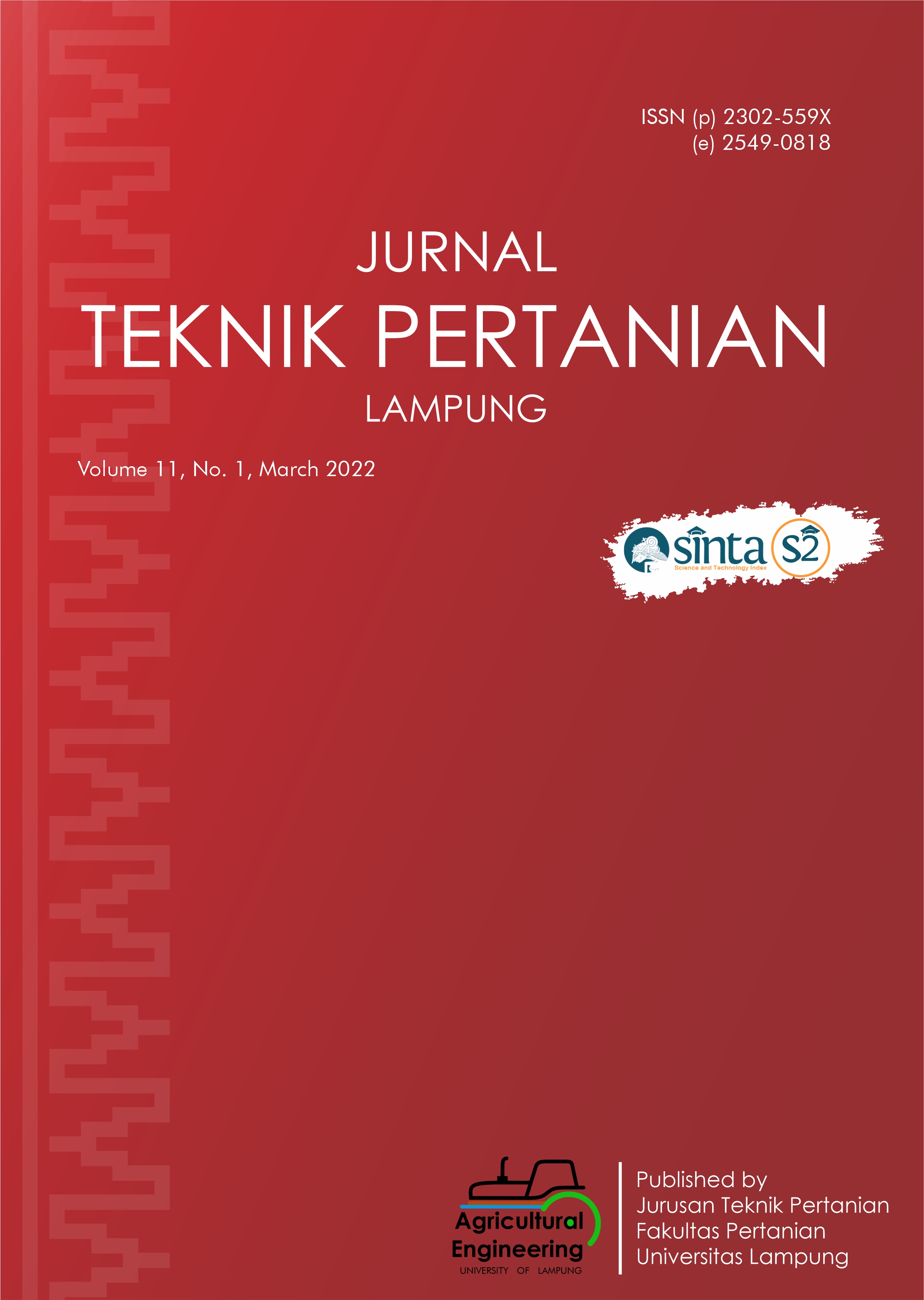Effect of Coconut Shell Biochar Application on the Effectivity of NPK Fertilizer in Red Onion (Allium ascalonicum L.) Cultivation
DOI:
https://doi.org/10.23960/jtep-l.v11i1.1-14Abstract
Shallot cultivation in Lampung faces challenges because the land is dominated by ultisol soils, which have low nutrients. Therefore, soil improvement materials such as biochar and fertilizers are needed. This study aims to determine the effect of coconut shell biochar addition on the effectiveness of NPK fertilizer in the production of shallots. The study was arranged in a Factorial Completely Randomized Design consisting of 2 factors, namely the dose of biochar (0, 40, 80, and 120 g/pot) and the dose of NPK fertilizer (0, 0,8, 1,6, and 2,4 g/pot). Each treatment combination was repeated 3 times. Parameters included soil characteristics (pH, soil volume shrinkage) and plant parameters (plant height, number of leaves, canopy area, buld number and diameter, evapotranspiration, fresh root weight, bulb air dry weight, and water productivity. The results showed that coconut shell biochar had a significant effect (± = 0.05) in increasing soil pH and decreasing soil shrinkage. The dose of biochar 80 g/pot (B2) with a dose of NPK 1.6 g/pot (N3) was the best treatment. In this treatment combination, shallots produced an average weight of 120.54 g/pot of fresh stover, 14 bulbs with diameter of 2.05 cm and air dry bulb weight of 70.17 g/pot, and the water productivity of 18.22 kg/m3.
Keyword: Canopy area, Fertilizer dose, pH, Soil shrinkage, Water productivity
References
Azmi, C., Hidayat, I.M. & Wiguna, G. 2011. Pengaruh Varietas dan Ukuran Umbi terhadap Produktivitas Bawang Merah. Jurnal Hortikultura, 21(3): 206–213.
Fuadi, N.A., Purwanto, M.Y.J. & Tarigan, S.D. 2016. Kajian Kebutuhan Air dan Produktivitas Air Padi Sawah dengan Sistem Pemberian Air secara SRI dan Konvensional Menggunakan Irigasi Pipa. Jurnal Irigasi, 11(1): 23–32.
Graber, E.R., Harel, Y.M., Kolton, M., Crtryn, E., Silber, A., David, D.R., Tsechansky, L., Borenshtein, M. & Elad, Y. 2010. Biochar Impact on Developmenr and Productivity of Pepper and Tomato grown in Fertigated Soilless Media. Plant Soil, 337: 481–496.
Hirsyad, F.Y. 2019. Respon Pertumbuhan dan Produksi Tanaman Bawang Merah (Allium axcalonicum L. ) terhadap Penggunaan Pupuk Kascing dan Pupuk NPK Mutiara 16:16:16. Pekanbaru: Universitas Islam Riau.
Nani, S. & Hidayat, A. 2005. Budidaya Bawang Merah (Panduan Teknis). Bandung: Balai Penelitian Tanaman Sayuran dan Pusat Pengembangan Hortikultura.
Nigussie, A., Kissi, E., Misganaw, M. & Ambaw, G. 2012. Effect Of Biochar Application On Soil Properties and Nutrient Uptake Of Lettuces (Lactuca Sativa) Grown In Chromium Polluted Soils. American-Eurasian Journal Agric. & Environ. Sci, 12(3): 369–376.
Notohadiprawito, T. 1973. The Relationships Of Consistency Indices To Some Other Properties Of Red-Yellow Podzolic Soils Of Indonesia. Proc. The second Asean Soil Conf, 2: 1–17.
Nurida, N.L., Dariah, A. & Sutono, S. 2015. Pembenah Tanah Alternatif untuk Meningkatkan Produktivitas Tanah dan Tanaman Kedelai di Lahan Kering Masam. Jurnal Tanah dan Iklim, 39(2): 99–108.
Nurida, N.L., Rachman, A. & Sutono. 2012. Alternatif Pemulihan Lahan Kering Masam terdegradasi dengan Formula Pembenah Tanah Biochar di Typic Kanhapludults. Lampung. Buana Sains, 12(1): 6.
Putrasamedja, S. & Soedomo, P. 2007. Evaluasi Bawang Merah yang Akan Dilepas. Jurnal Pembangunan Pedesaan, 7(3): 133–146.
Rahayu, Saidi, D. & Herlambang, S. 2019. Pengaruh Biochar Tempurung Kelapa dan Pupuk Kandang Sapi terhadap Sifat Kimia Tanah dan Produksi Tanaman Sawi pada Tanah Pasir Pantai. Jurnal Tanah Dan Air (Soil And Water Journal), 16(2): 69–78.
Rusdiana, O., Fakuara, Y., Kusmana, C. & Hidayat, Y. 2000. Tanah yang padat memiliki aerasi udara dan kapasitas infiltasi air yang rendah sehingga menghambat perkembangan akar tanaman. Jurnal Manajemen Hutan Tropika, 6(2).
Saputra, F.E. 2016. Respons Tanaman Bawang Merah (Allium ascalonicum L.) Akibat Aplikasi Pupuk Hayati dan Pupuk Majemuk NPK dengan berbagai Dosis. Fakultas Pertanian: Universitas Lampung.
Soemeinaboedhy, I.N. & Tejowulan, R.S. 2007. Pemanfaatan Berbagai Macam Arang Sebagai Sumber Unsur Hara P Dan K serta Sebagai Pembenah Tanah. Agroteksos, 17(2): 114–122.
Southavong, S. 2012. Effect of Soil Amender (Biochar or Charcoal) and Biodigester Effluent on Growth and Yield of Water Spinach, Rice and on Soil Fertility. Agricultural Sciences Animal Husbandy: Can Tho University.
Tania, N., Astina & Budi, S. 2012. Pengaruh Pemberian Pupuk Hayati terhadap Pertumbuhan dan Hasil Jagung Semi pada Tanah Podsolik Merah Kuning. Jurnal Sains Mahasiswa Pertanian, 1(1): 10–15.
Verheijen, F., Jeffery, S., Bastos, A., Velde, M. & Diafas, I. 2010. Biochar Application to Soils: A Critical Scientific Review of Effects on Soil Properties, Processes and Function. EUR. Scientific and technical research series, 24099. Luxembourg: European Commiccion Publication Office.
Yuan, J.H., Quan, W.R.K. & Wang, R.H. 2011. Comparation of ameliorating effect on an acidic ultisol between four crop straw and their biochars. Journal of soil and Sediment, 11(5): 741–750.
Downloads
Published
Issue
Section
License
- Authors who publish with this journal agree to the following terms:
- Authors retain copyright and grant the journal right of first publication with the work simultaneously licensed under a Creative Commons Attribution-ShareAlike 4.0 International Lice that allows others to share the work with an acknowledgement of the work's authorship and initial publication in this journal.
- Authors are able to enter into separate, additional contractual arrangements for the non-exclusive distribution of the journal's published version of the work (e.g., post it to an institutional repository or publish it in a book), with an acknowledgement of its initial publication in this journal.
- Authors are permitted and encouraged to post their work online (e.g., in institutional repositories or on their website) prior to and during the submission process, as it can lead to productive exchanges, as well as earlier and greater citation of published work (See The Effect of Open Access).
Jurnal Teknik Pertanian Lampung

JTEPL is licensed under a Creative Commons Attribution-ShareAlike 4.0 International License.

